
Revisión de Maple en Aerospace America
- Detalles
- Categoría: Mathematica
- Visto: 2512
El pasado mes de marzo de 2005 apareció en la Sección SYSTEM & SOFTWARE de la publicación
Aerospace America bajo el título
Tapping into Maple’s Problem Solving Power, firmado por John D. Binder, una completa revisión de la herramienta de cálculo analítico
Maple y de sus
herramientas complementarias.
El artículo en cuestión analiza la problemática del uso de herramientas de software por parte de los profesionales y de las ventajas que presenta Maple para solventar esa problemática.
"[...] Engineers today depend on a variety of software tools to help them do the work they are paid to do. Employers usually provide these tools, now that they have become a vital part of the engineering process. Often they are extensive and rather costly, providing more capability than the engineer really needs. In addition, unfamiliar tools may require several weeks of training, with proficiency coming only after actual use. For a casual user of these engineering tools, the ramp-up time is too long, and the engineer spends more time learning how to use the tool than in actually applying it to a project. One software program is looking to change all that. Maple is an environment for scientific and engineering problem solving, mathematical exploration, data visualization, and technical authoring.[...]"
El artículo también cubre las herramientas complementarias a Maple en el ámbito de la industria: MapleNET y las librerías: Maple Database Integration Toolbox y Global Optimization Toolbox.
Finalmente el artículo analiza de forma breve el uso de Maple por la Canadian Space Agency (CSA) y Matsushita:
"[...] In another case, an engineer at Matsushita’s semiconductor development division is tasked with the design of large scale integrated (LSI) circuits. His team is designing specialized analog circuits and, more specifically, electronic filters and phase-locked loops. Maple is used during the early stages of circuit design, analyzing circuits, or calculating the precision of the LSIs that are designed.[...]"
Lectura completa del artículo (en línea):
Binder, John D. Tapping into Maple’s Problem Solving Power. Aerospace America. March 2005.
El artículo en cuestión analiza la problemática del uso de herramientas de software por parte de los profesionales y de las ventajas que presenta Maple para solventar esa problemática.
"[...] Engineers today depend on a variety of software tools to help them do the work they are paid to do. Employers usually provide these tools, now that they have become a vital part of the engineering process. Often they are extensive and rather costly, providing more capability than the engineer really needs. In addition, unfamiliar tools may require several weeks of training, with proficiency coming only after actual use. For a casual user of these engineering tools, the ramp-up time is too long, and the engineer spends more time learning how to use the tool than in actually applying it to a project. One software program is looking to change all that. Maple is an environment for scientific and engineering problem solving, mathematical exploration, data visualization, and technical authoring.[...]"
El artículo también cubre las herramientas complementarias a Maple en el ámbito de la industria: MapleNET y las librerías: Maple Database Integration Toolbox y Global Optimization Toolbox.
Finalmente el artículo analiza de forma breve el uso de Maple por la Canadian Space Agency (CSA) y Matsushita:
"[...] In another case, an engineer at Matsushita’s semiconductor development division is tasked with the design of large scale integrated (LSI) circuits. His team is designing specialized analog circuits and, more specifically, electronic filters and phase-locked loops. Maple is used during the early stages of circuit design, analyzing circuits, or calculating the precision of the LSIs that are designed.[...]"
Lectura completa del artículo (en línea):
Binder, John D. Tapping into Maple’s Problem Solving Power. Aerospace America. March 2005.

